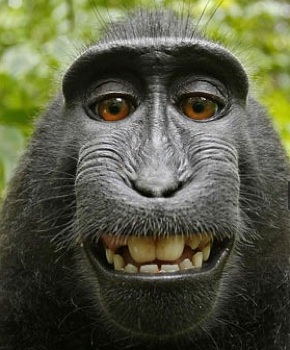Caters News Agency claims to have bought exclusive rights to the iconic self-portrait taken by a macaque that snatched a photographer's camera while the latter was shooting on Sulawesi. Caters has sent copyright threats to some sites that reproduced the image, prompting Techdirt (one of the nastygram recipients) to delve deeply into the question of the copyrightability of works created by non-humans.
Under US law (we'll deal with elsewhere soon), you have to have made the creative contributions (the copyrightable aspects) to the image to have it qualify for any copyright protection (and then, it's only the creative aspects that get the copyright). Thus, you could argue that if the photographer had set up the camera, framed the shot, and simply let the monkey click the shutter, perhaps there is some copyright there (though, even then it would likely be limited to some of the framing, and not much else). But David Slater has already admitted that the monkeys found a camera he had left out by accident and that he did not have anything to do with setting up the shot. He's stated that the monkeys were playing with the shiny objects and when one pushed the shutter, the noise interested them and they kept it up. It would be difficult to argue he made any sort of creative contribution here to warrant copyright.
Can the monkeys get the copyright? No. As Justin Levine kindly pointed out, according to the rules published by the US Copyright Office:
503.03 Works not capable of supporting a copyright claim.
Claims to copyright in the following works cannot be registered in the Copyright Office:
503.03(a) Works-not originated by a human author.
In order to be entitled to copyright registration, a work must be the product of human authorship. Works produced by mechanical processes or random selection without any contribution by a human author are not registrable. Thus, a linoleum floor covering featuring a multicolored pebble design which was produced by a mechanical process in unrepeatable, random patterns, is not registrable. Similarly, a work owing its form to the forces of nature and lacking human authorship is not registrable; thus, for example, a piece of driftwood even if polished and mounted is not registrable
Can We Subpoena The Monkey? Why The Monkey Self-Portraits Are Likely In The Public Domain

